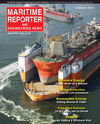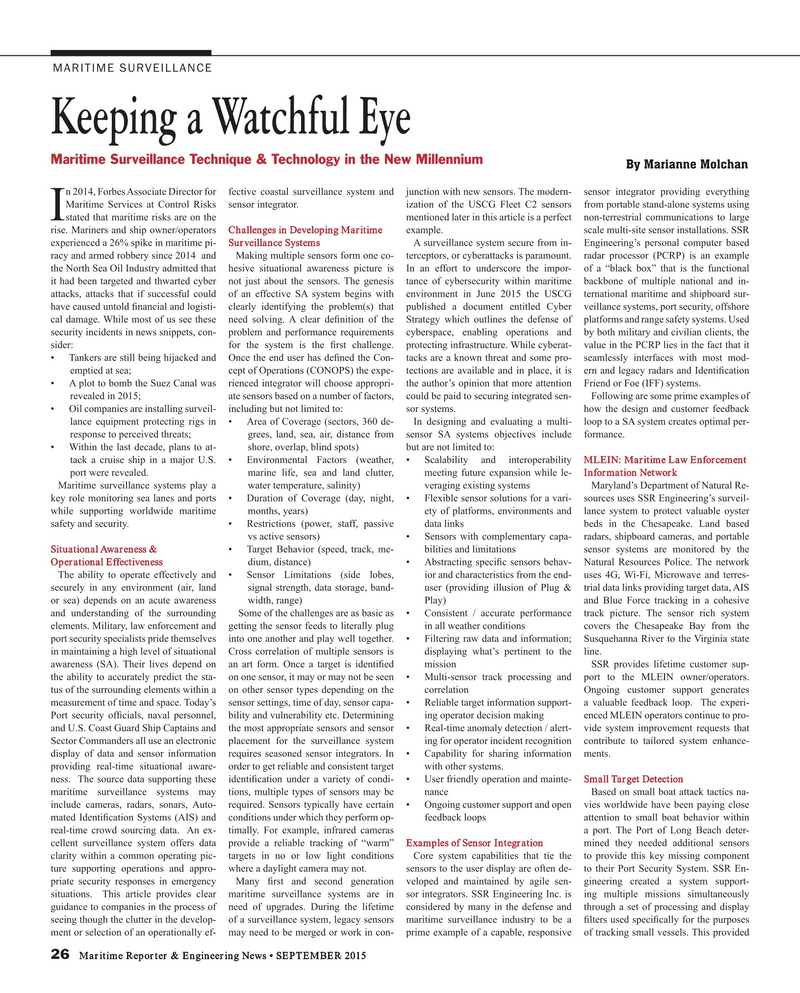
Page 26: of Maritime Reporter Magazine (September 2015)
Offshore Energy Technologies
Read this page in Pdf, Flash or Html5 edition of September 2015 Maritime Reporter Magazine
MARITIME SURVEILLANCE
Keeping a Watchful Eye
Maritime Surveillance Technique & Technology in the New Millennium
By Marianne Molchan n 2014, Forbes Associate Director for fective coastal surveillance system and junction with new sensors. The modern- sensor integrator providing everything
Maritime Services at Control Risks sensor integrator. ization of the USCG Fleet C2 sensors from portable stand-alone systems using
I stated that maritime risks are on the mentioned later in this article is a perfect non-terrestrial communications to large rise. Mariners and ship owner/operators Challenges in Developing Maritime example. scale multi-site sensor installations. SSR experienced a 26% spike in maritime pi- Surveillance Systems A surveillance system secure from in- Engineering’s personal computer based racy and armed robbery since 2014 and Making multiple sensors form one co- terceptors, or cyberattacks is paramount. radar processor (PCRP) is an example the North Sea Oil Industry admitted that hesive situational awareness picture is In an effort to underscore the impor- of a “black box” that is the functional it had been targeted and thwarted cyber not just about the sensors. The genesis tance of cybersecurity within maritime backbone of multiple national and in- attacks, attacks that if successful could of an effective SA system begins with environment in June 2015 the USCG ternational maritime and shipboard sur- have caused untold ? nancial and logisti- clearly identifying the problem(s) that published a document entitled Cyber veillance systems, port security, offshore cal damage. While most of us see these need solving. A clear de? nition of the Strategy which outlines the defense of platforms and range safety systems. Used security incidents in news snippets, con- problem and performance requirements cyberspace, enabling operations and by both military and civilian clients, the sider: for the system is the ? rst challenge. protecting infrastructure. While cyberat- value in the PCRP lies in the fact that it • Tankers are still being hijacked and Once the end user has de? ned the Con- tacks are a known threat and some pro- seamlessly interfaces with most mod- emptied at sea; cept of Operations (CONOPS) the expe- tections are available and in place, it is ern and legacy radars and Identi? cation • A plot to bomb the Suez Canal was rienced integrator will choose appropri- the author’s opinion that more attention Friend or Foe (IFF) systems. revealed in 2015; ate sensors based on a number of factors, could be paid to securing integrated sen- Following are some prime examples of • Oil companies are installing surveil- including but not limited to: sor systems. how the design and customer feedback lance equipment protecting rigs in • Area of Coverage (sectors, 360 de- In designing and evaluating a multi- loop to a SA system creates optimal per- response to perceived threats; grees, land, sea, air, distance from sensor SA systems objectives include formance.
• Within the last decade, plans to at- shore, overlap, blind spots) but are not limited to: tack a cruise ship in a major U.S. • Environmental Factors (weather, • Scalability and interoperability MLEIN: Maritime Law Enforcement port were revealed. marine life, sea and land clutter, meeting future expansion while le- Information Network
Maritime surveillance systems play a water temperature, salinity) veraging existing systems Maryland’s Department of Natural Re- key role monitoring sea lanes and ports • Duration of Coverage (day, night, • Flexible sensor solutions for a vari- sources uses SSR Engineering’s surveil- while supporting worldwide maritime months, years) ety of platforms, environments and lance system to protect valuable oyster safety and security. • Restrictions (power, staff, passive data links beds in the Chesapeake. Land based vs active sensors) • Sensors with complementary capa- radars, shipboard cameras, and portable
Situational Awareness & • Target Behavior (speed, track, me- bilities and limitations sensor systems are monitored by the
Operational Effectiveness dium, distance) • Abstracting speci? c sensors behav- Natural Resources Police. The network
The ability to operate effectively and • Sensor Limitations (side lobes, ior and characteristics from the end- uses 4G, Wi-Fi, Microwave and terres- securely in any environment (air, land signal strength, data storage, band- user (providing illusion of Plug & trial data links providing target data, AIS or sea) depends on an acute awareness width, range) Play) and Blue Force tracking in a cohesive and understanding of the surrounding Some of the challenges are as basic as • Consistent / accurate performance track picture. The sensor rich system elements. Military, law enforcement and getting the sensor feeds to literally plug in all weather conditions covers the Chesapeake Bay from the port security specialists pride themselves into one another and play well together. • Filtering raw data and information; Susquehanna River to the Virginia state in maintaining a high level of situational Cross correlation of multiple sensors is displaying what’s pertinent to the line. awareness (SA). Their lives depend on an art form. Once a target is identi? ed mission SSR provides lifetime customer sup- the ability to accurately predict the sta- on one sensor, it may or may not be seen • Multi-sensor track processing and port to the MLEIN owner/operators. tus of the surrounding elements within a on other sensor types depending on the correlation Ongoing customer support generates measurement of time and space. Today’s sensor settings, time of day, sensor capa- • Reliable target information support- a valuable feedback loop. The experi-
Port security of? cials, naval personnel, bility and vulnerability etc. Determining ing operator decision making enced MLEIN operators continue to pro- and U.S. Coast Guard Ship Captains and the most appropriate sensors and sensor • Real-time anomaly detection / alert- vide system improvement requests that
Sector Commanders all use an electronic placement for the surveillance system ing for operator incident recognition contribute to tailored system enhance- display of data and sensor information requires seasoned sensor integrators. In • Capability for sharing information ments.
providing real-time situational aware- order to get reliable and consistent target with other systems.
ness. The source data supporting these identi? cation under a variety of condi- • User friendly operation and mainte- Small Target Detection maritime surveillance systems may tions, multiple types of sensors may be nance Based on small boat attack tactics na- include cameras, radars, sonars, Auto- required. Sensors typically have certain • Ongoing customer support and open vies worldwide have been paying close mated Identi? cation Systems (AIS) and conditions under which they perform op- feedback loops attention to small boat behavior within real-time crowd sourcing data. An ex- timally. For example, infrared cameras a port. The Port of Long Beach deter- cellent surveillance system offers data provide a reliable tracking of “warm” Examples of Sensor Integration mined they needed additional sensors clarity within a common operating pic- targets in no or low light conditions Core system capabilities that tie the to provide this key missing component ture supporting operations and appro- where a daylight camera may not. sensors to the user display are often de- to their Port Security System. SSR En- priate security responses in emergency Many ? rst and second generation veloped and maintained by agile sen- gineering created a system support- situations. This article provides clear maritime surveillance systems are in sor integrators. SSR Engineering Inc. is ing multiple missions simultaneously guidance to companies in the process of need of upgrades. During the lifetime considered by many in the defense and through a set of processing and display seeing though the clutter in the develop- of a surveillance system, legacy sensors maritime surveillance industry to be a ? lters used speci? cally for the purposes ment or selection of an operationally ef- may need to be merged or work in con- prime example of a capable, responsive of tracking small vessels. This provided 26 Maritime Reporter & Engineering News • SEPTEMBER 2015
MR #9 (26-33).indd 26 MR #9 (26-33).indd 26 9/9/2015 9:27:45 AM9/9/2015 9:27:45 AM

 25
25

 27
27
